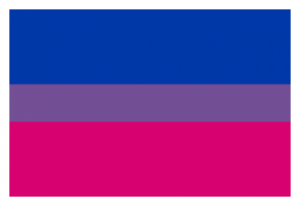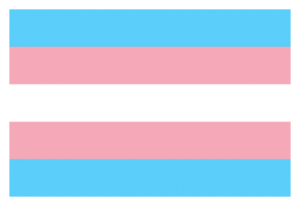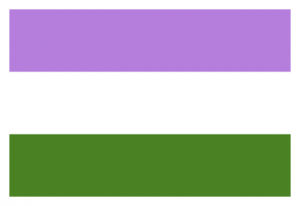As many terms as identities
We know, big acronyms confuse you, while terms and their content make you anxious. The existence of more terms though, is important so that every person can express more effectively their identity in all of its complexity, and big acronyms contribute in the visibility of more identities, beyond the mainstream ones.
In this page you can find the meaning of every term, so as you’re not afraid anymore.
Bisexual
A person that is attracted to two genders or more. It is often used as an umbrella term to describe various forms of polysexuality.

Biphobia
Όρος παράλληλος με αυτόν την ομοφοβίας που αναφέρεται στην ψυχολογική και κοινωνική προκατάληψη και στις διακρίσεις κατά των αμφισεξουαλικών προσώπων. Πέρα από αρνητικούς χαρακτηρισμούς, δηλώσεις όπως «Τα bi άτομα είναι αναποφάσιστα» ή «δεν υπάρχουν bi άτομα» επίσης είναι αμφιφοβικές.
Αsexual
Also called ace. Someone who does not experience (or experiences little) sexual attraction to other people. Asexuality is often considered as a spectrum (asexual/ace spectrum) that includes asexuality at one end, gray-asexuality (or graysexuality) in the middle, and (allo)sexuality at the other end.

Sex
Sex is defined as the set of biological characteristics such as gonads, sex chromosomes, hormones, external and internal genitals that are used to assign a gender at birth by the medical community. Sex is a spectrum that covers the full variety of bodies, the most usual of which is female (vagina, clitoris, XX xhromosomes, large breasts etc) and male (penis, testicles, XY chromosomes). Other combinations of sex characteristics define intersex people. Many people deconstruct the idea of biological sex, and only refer to biological and anatomical characteristics.
Gay
A person that experiences romantic and/or sexual attraction to people of the same gender. The term gay in Greece is used mainly by men, although there are women that use this term to describe their sexual and/or romantic orientation. ("gay woman", woman that is attracted romantically and/or sexually by other women)
Gender Identity Disorder
A diagnostic category of DSM-IV and ICD-10 that is assigned to trans people that wish to transition. Diagnostic criteria include the persistent and strong identification with a different gender than the one assigned at birth, as well as strong dysphoria at the gender assigned at birth.
Transgender
People whose gender is not the same as the gender they were assigned at birth. Some trans people undergo gender reassignment procedures, however it must be noted that -contrary to common belief- not all trans people wish to undergo such procedures. Often, the term trans is used to describe only trans men and trans women, erasing the identities of non-binary trans people. It is important that this does not happen and that the experiences of self-determination is respected.

Binary Model of Sexual Orientation
The separation of sexual orientation to two, and only two, categories: heterosexual and homosexual. This opinion excludes people that are attracted to more than one gender (bi/pan) as well as people that do not experience sexual or romantic attraction (asexual, aromantic etc)
Gender binary
The belief that there are only two genders: man and woman. According to this theory there are no people that identify with fluid or non-binary genders.
As a model, it is -mainly- a product of Western civiliaztion. Other civilizations user more or less different models to categorize genders.
Gender Dysphoria
A diagnostic category used in DSM-V insteaad of "Gender Identity Dysphoria" in an attempt to reduce the stigma that trans people experience. The diagnostic criterion for gender identity dysphoria is the existence of clinically important dysphoria that originates by the difference between a person's gender identity and the gender identity that other people have assigned based on sexual characteristics.
Ego-dystonic sexual orientation
A diagnostic category of DSM-III (which in the current version DSM-V has become obsolete) and of ICD-10. The manual clarifies that any sexual orientation, by itself, does not constitute a disorder and states that a disorder exists in the case of a person that experiences some form of dysphoria or willingness to change theirsexual orientation.
Gender Expression
Gender expression refers to the ways in which a person expresses their masculinity, femininity or other gender-related behaviours and characteristics in the social system, and specifically the way they express to other people the way that they experience their gender identity. Gender expression can be characteristics such as a hairdo, clothing or the way a person moves. The social construct dictates that gender expression is consistent with gender identity, that is it exects a man to have a masculine gender expression and a woman to have a feminine gender expression.
Internalised Biphobia
The negative feelings towards bisexuality that bisexual people can develop towards themselves and towards other people that identify as bisexual. They are created by the internalisation of negative beliefs of other people or the society against bisexuality.
Internalised Homophobia
The negative feelings towards homosexuality that homosexual people can develop towards themselves and towards other people that identify as homosexual. They are created by the internalisation of negative beliefs of other people or the society against homosexuality.
Internalised Transphobia
The negative feelings towards that trans people can develop towards themselves and towards other people that identify as trans. They are created by the internalisation of negative beliefs of other people or the society against trans people.
Gender Reassignment
Gender reassignment is the medical body-forming procedures that a person may undergo so as to align the image of their body to their experience. It is also redered as "Sex change", a term that should be avoided.
Heteronormativity
A term that was developed in the context of Queer Theory and describes the socially imposed gender binary as well as that belief that heterosexuality is the only normal and acceptable sexual orientation.
Heterosexism
The belief that heterosexuality is the only normal sexual orientation, superior to other sexual orientations, and is accompanied with the belief that people are exlusively heterosexual (Fish, 2007). Heterosexism is directly connected with homophobia, but it is different in the sense that heterosexism is an oppression system that is integrated to the dominant social, cultural and financial institutions.
Straight
A person that experiences romantic and/or sexual attraction to people of the opposite gender. This term is based on the acceptance of the gender binary, hence the use of the word "hetero-".
Gender
It is a social construct that includes roles, behaviours, norms, activities and characteristics that a society or culture of a given historic moment assigns as typical to a woman or a man (based on the gender binary). Gender is, thus, inextricably linked to the social expectations of the presumed biological sex of a person.
Lesbian
A person that identifies as a woman (see gender identity) and experiences emotional, romantic, and/or sexual attraction to people of the same gender. Some women prefer to identify as gay or gay women.
Lesbophobia
See homophobia
Intersex
Homophobia
The psychological and social prejudice, the discrimination and the illogical fear towards homosexual people. Se also: Biphobia, Transphobia
Homosexual
Very few people will use the term "homosexual" to describe themselves in the youth community, as it is a term that has been widely used in the medical community. However, the term homosexuality is widely used to describe the phenomenon of attraction to people of the same gender. Also see Gay, Lesbian.
Ρansexual
A person that experiences emotional, romantic and/or sexual attraction to people of any gender. Often pansexual people declare that the biological sex or the gender of a person are not important parameters of whether they will experience attraction to a person. Alternatively, they can be described with the term gender blind.

Transvestite
The term, meaning wise, is the same as the term crossdresser, however it is avoided because of social and medical stigma, as transvestism is a diagnostic category in mental disorder manuals. Additionally, the adapted term "travesti" has been used for decades to describe trans people. The term is so socially stigmatised that it should always be avoided and is abusive for most trans people, except for those that identify with the term (usually older trans people).
Polygamy
Traditionally used to describe the phenomenon of a person conducting more than one marriage during the same time period. It can also be used for people who have honest and consensual sexual relationships with more than one person.
Polyamory
It is a relationship model according to which a romantic and/or sexual relationship is open and allows its members to create romantic and/or sexual relationships with other people at the same time, which can be assimilated to the initial relationship (leading to relationships of 3 or more people) or not. Polyamory is ideologically based on the elimination of possessiveness, honesty, sharing and emotional closeness of its members.

Polysexual
A person that experiences emotional, romantic and/or sexual attraction to people of more than one gender.
Romantic Orientation
Term corresponding to sexual orientation, the term focuses on the emotional-romantic dimension. It refers to the gender of the people a person is attracted romantically from, can fall in love with, can form a relationship with. The romantic and sexual orientation of a person is not necessarily the same.
Sexism
The term sexism refers to the systemic discrimination and oppression that is experienced by people that are not men (mainly women and people that are perceived as women) based solely on their gender or their body. Sexism has been created by the patriarchical structure of our society that is based on the superiority of men and masculinity. Homophobia, biphobia and, especially, transphobia are all based on sexism. Sexism is an oppression system that is integrated to the dominant social, cultural and financial institutions and is often ignored in its smaller manifestations.
Sexual Identity
The way in which a person experiences their sexuality, namely their sexual or romantic attraction to other people. The term can be used almost interchangeably with the term sexual orientation.
Sexual Orientation
Sexual orientations refers to one's ability to feel emotional and/or sexual attraction to other people and one's ability to maintain personal and sexual relationships with these people.
Gender Identity
Gender identity refers to the personal and internal way that a person experiences their gender. It can coincide with the gender assigned at birth or not.
Trans
People whose gender is not the same as the gender they were assigned at birth. Some trans people undergo gender reassignment procedures, however it must be noted that -contrary to common belief- not all trans people wish to undergo such procedures. Often, the term trans is used to describe only trans men and trans women, erasing the identities of non-binary trans people. It is important that this does not happen and that the experiences of self-determination is respected.

Transphobia
It is the irrational fear and hate towards trans people and all people that are prwsumed to violate traditional notions about gender identity, gender and/or gender expression.
Τransexual
A term that refers to trans individuals that have gone through gender reassignment procedures. However, it is a term that is not used any more because of its negative stigma. The word trans is usually used. There are trans people, usually older, that use this term for themselves. It is important to respect a person's will to self-identify as they want.
Gender Assigned At Birth
The gender, both socially and legally, that is assigned to a person at their birth based on the person's biological characteristics.
Transition
It is the procedures that a person undergoes so that they can change the way their gender is presented socially and/or medically and/or legally. That is accomplished socially through following norms and behaviours that characterise their gender, medically through hormone therapy or gender reassignment procedures etc, and legally by changing the gender on the corresponding legal papers. This procedure can vary greatly between different individuals.
Agender
Gender identity according to which a person experiences no gender or the absence of gender identity.
Androgynous
A term that is used for people whose gender expression has both typically masculine and typically feminine characteristics.
Aromantic
A person that does not experience romantic-emotional attraction to other people and has low or no interest in any form of romantic relationship.
Cisgender/ Cis
A person whose gender identity is not different to the gender assigned at birth. The term is used as the opposite of trans.
Cissexism
It is the belief that cis people are superior to trans people, with the result of trans people going through discrimination, including discrimination that devalues the bodies and the gender expression of trans people that do not conform to the cis norm. Cissexism is an oppression system that is integrated to the dominant social, cultural and financial institutions. Phrases such as “Menstrual pads are women's products” or “Men should check their prostate as they get older” are cissexist as there are men that go through menstruation and women that have prostates.
Crossdresser
A person that wears clothes that are usually related to the “opposite” gender (based on the gender binary), in the context of a specific society. Crossdressers are not necessarily trans.
Drag King/ Drag Queen
People that dress in the clothes of one of the two dominant genders trying to mock the gender norms and the gender binary and/or to artistically express themselves.
Genderfluid
A person that experience fluid or alternating gender identity.
Genderneutral
It is the neutral gender expression, that cannot be identified as sterotypically “masculine” or stereotypically “feminine”.
Genderqueer
It is a set of gender identities that cannot be characterised as typically “male” or typically “female” and do not conform to the gender binary and heteronormativity.

Τwo-spirit
A gender identity, according to which a person feels both a woman and man at the same time. The term “two-spirit” was first used by Native Americans for people that, they believed, were inhabited by both the male and the female spirit at the same time.
Queer
Ένας πολύπλοκος όρος με πολλαπλές ερμηνείες. Χρησιμοποιείτο στο παρελθόν ως υποτιμητικός όρος προς τα άτομα με ομόφυλο σεξουαλικό προσανατολισμό*, αλλά στη δεκαετία του 1980 υιοθετήθηκε από ακτιβιστές και θεωρητικούς ως θετικός και συγκρουσιακός αυτό-χαρακτηρισμός σε μια προσπάθεια να προκαλέσουν τις κοινωνικές νόρμες σχετικά με την σεξουαλικότητα, τον σεξουαλικό προσανατολισμό*, την ταυτότητα φύλου* ή/και άλλες μορφές κανονικότητας. Χρησιμοποιείται συχνά από άτομα που δεν αποδέχονται τις παραδοσιακές έννοιες φύλων και σεξουαλικότητας και δεν ταυτίζονται/ καλύπτονται με κάποιο από τους υπόλοιπους όρους του ακρωνυμίου ΛΟΑΤΙ+ αλλά και ως όρος-ομπρέλα για όλα τα LGBTQI+ άτομα. Ως όρος ταυτίζεται και με συγκεκριμένα κομμάτια της Queer Theory (Queer Θεωρίας).
